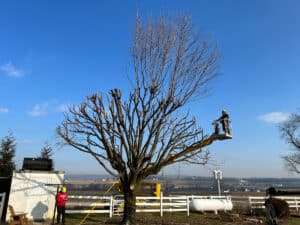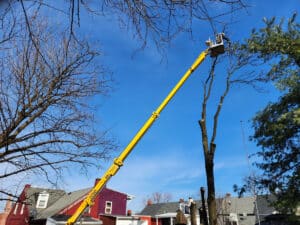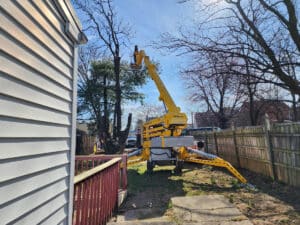- Tree limbs and branches that hang onto a neighbor’s property (or from your neighbor’s, onto yours), can usually be cut down or trimmed by the property owner onto which they encroach. Be sure to know your local regulations (city ordinances often regulate tree trimming), and only cut the wood that is on your property.
- A fallen tree or limb from a neighbor’s property onto your property becomes your property, and you have the right to take care of it. You can ask your neighbor for help, but it is no longer their responsibility without the court’s intervention.
- It is not legal to cut down a tree on someone else’s property simply because it threatens your land. If you are worried about a hazard tree that poses an unreasonable danger to your property, a court may be able to order your neighbor to address the issue. Don’t take matters into your own hands.
- Trees from your property that encroach public rights of way may be your responsibility. This can be especially tricky with roots that are damaging sidewalks. Once a limb or tree falls, however, it is often the responsibility of the locality.
Pennsylvania Tree Laws Explained: The Basics
Pennsylvania’s climate makes our state an absolute haven for beautiful tree growth, large old-growth wood, and extensive foliage. Our forebears rightly named it “Penn’s Woods” for a reason: left undisturbed, our Lancaster County ground would be covered in dense forests!
But while trees provide beauty, shade, and life-giving oxygen, they can pose hazardous and financial risks to property and individuals. Often, these risks lead to conflicts and disputes between neighbors. The questions of property rights and responsibilities regarding trees are complex, but being informed on the basics of Pennsylvania’s tree laws can help guide you and keep your relationship with neighbors intact.
We get calls from concerned property owners asking about their legal rights to remove or trim trees on private property all the time. This includes questions about trees on their property, trees on neighboring properties, and trees near property lines.
We’ll get into the specifics in a moment, but generally speaking, a Pennsylvania property owner should be concerned with two or three potential regulatory frameworks:
- State law, called statutes
- Local government or municipal regulations, called ordinances
- Preceding case law, called common law, sometimes from the state’s commonwealth court
We primarily to tree removals and tree service work within Lancaster, Chester, and surrounding counties, meaning that laws regulating property lines and tree upkeep are managed by wide-ranging ordinances specific to your local municipality. Still, some commonalities apply.
Common Issues With Trees and Abutting Property Owners
As a professional tree service company, we frequently get called to weigh in on disputes between neighbors regarding trees. Common issues include overhanging branches or tree limbs, fallen trees or debris, and hazardous trees near property lines.
Let’s start with one of the most common questions we get, and a slightly thorny issue if you aren’t on the best terms or have neighbor issues.
1. What are the laws for limbs and branches from my neighbor’s tree hanging over my property?
Assuming that the neighbor with the invading branches and limbs refuses to address the issue, as a property owner, you are within your rights to take self-help measures to trim or remove the tree limbs overhanging your space.
In cases where a contractor is hired to perform the work, the cost of removal is the responsibility of the neighbor with the invading tree. However, the expense of litigation to resolve an unwilling neighbor’s refusal to foot the bill can often outweigh the cost of tree removal for a hazard tree.
To determine if litigation is financially the right move, it can be helpful to gather the facts on the average cost to remove trees in Lancaster County. Better yet, just give us a call!
Overhanging Branches From a Neighbor’s Tree or Neighboring Property
If you find that your neighbor’s tree branches are extending onto your property and pose a risk, you likely have the right to trim or remove those branches yourself. Of course, if neighborly disputes are common, it can be easier to wait until the branch falls.
Overhanging Branches From Your Tree
If branches or limbs from your tree hang over your neighbor’s property, you are responsible for addressing the issue. If you fail to do so, your neighbor may be entitled to mitigate the issue by trimming or removing the overhanging branches (including trees and shrubs). Even if your tree is damaged or killed in the process, if the tree threatens their space, your neighbor is within their rights to protect their property from your tree’s intrusion.
Overhanging Branches From a Tree Straddling Property Lines
When a tree trunk straddles property lines, both property owners have shared responsibility for the tree and its maintenance. If the ownership of the tree is disputed, consider who planted the tree and where the majority of the tree trunk is located.
Again, if an overhanging branch is on your property, you likely have the right to trim or remove it. But for further maintenance or removing the entire tree or stump from your property line, you may need to seek legal representation and let a court decide the tree’s ownership.
2. What if my neighbor’s tree along our property line is a hazard?
A tree posing a potential risk to your property, such as leaning dangerously or showing obvious signs of dead branches, should be brought to your neighbor’s attention immediately. Many avoid addressing hazardous trees until it’s too late for any action to be taken and the tree has already fallen and caused damage.
If your neighbor is unwilling to remove the hazardous tree or take necessary precautions, you are not within your rights to take matters into your own hands and remove the tree. If the tree’s base or hanging branches are not on your property, any attempt to remove the tree will likely be considered trespassing and destruction of property.
To address this issue, you may need to seek legal action within the county court system to have a judge determine the appropriate next steps. In most cases, the judge may order an arborist to assess the tree’s condition and if removal is necessary. If the tree does pose a hazardous risk, the tree’s owner is responsible for removing the tree.
3. What if my neighbor’s tree or limbs fall onto my property?
In Pennsylvania, if your neighbor’s tree falls or debris falls onto your property, you are responsible for removing it from your property. It’s best to allow your neighbor the opportunity to volunteer to help you in the cleanup process, but that is not legally required.
Tree Negligence and Financial Liability
In the case of financial disputes related to tree removal or damage, the person responsible depends on whether the tree was healthy and well-maintained or if the incident resulted from negligence.
Negligence includes failing to properly maintain the tree, ignoring signs of rot or disease, or neglecting to address potential hazards like dead branches and hanging limbs. If steps are not taken to prevent the potential damage, the tree’s owner is financially liable for any resulting damages or costs associated with the removal or repair.
If the tree’s owner can prove that they took reasonable care to maintain the tree or the incident was an unforeseeable force of nature, they are not financially liable for any costs.
Duty of Care and Tree Damage Prevention
The duty of care applied to tree owners in Pennsylvania requires close and diligent monitoring of the health of all trees on your property, particularly trees growing near other properties (or even tree roots), and trees along property lines. Special consideration should be taken for trees near public roadways, sidewalks, and neighboring properties. Regular inspection and maintenance are essential for protecting your property and preventing potential harm or damage to others.
Failure to do so can result in legal consequences and financial liability if damage or injury occurs from negligence.
Last, before removing a tree on your property – particularly if you live within city limits – it’s a good idea to look into local laws regarding tree removal permits and determine if one is necessary for your situation. We can help with that, too.
Common Issues With Private Trees and Municipalities
The potential conflict between private tree owners and municipalities is often an overlooked aspect of tree laws in Pennsylvania. It may seem like a property owner has full control over the trees on their land, but local regulations frequently come into play for trees near public rights of way, such as sidewalks and roadways.
1. Am I responsible for my trees in the public right of way?
First, let’s define the public right of way and what it means for you and the trees on your property. A public right of way refers to the public’s right to travel without hindrance over sidewalks and streets on city or town property. This means that if your tree’s roots disrupt the integrity of the sidewalk, tree limbs overhang power lines, or branches are at risk of falling, your tree’s days may be numbered.
Any tree within the bounds of a public right of way is typically part of a joint ownership between multiple parties.
One is the property owner, responsible for maintaining the tree, and the other is the municipality, responsible for ensuring the safety and functionality of the public right of way. The other party involved is public utility companies responsible for removing or trimming trees that pose a risk to power lines or other utilities.
Bottom line, as a property owner you own the tree, but the municipality controls what happens to the tree if it is in the line of a public right of way. If part of the required maintenance of your tree requires removal, you must have permission from the municipality.
Before removal, it’s worth understanding when tree removal permits are required. We generally have a good sense for this when we talk over the project with you, the property owner.
2. What happens if my tree falls in the public right of way?
Although there are frustrations to having to essentially share ownership with the municipality in the case of trees in the public right of way, there are advantages to this arrangement.
If a tree on your property falls into the public right of way, you are often not responsible for resulting damages or injuries. The municipality assumes liability and presumed negligence for not preventing the incident. However, if the municipality had issued an ordinance before the incident, urging the property owner to perform maintenance on the tree, the liability may shift back to the property owner.
3. Who is responsible for root damage to sidewalks in the public right of way?
Interestingly, any damage or injury caused by the roots of a tree in the public right of way is the property owner’s responsibility.
If your tree’s roots lift the sidewalk, causing cracks or uneven surfaces, you are responsible for repairing the damage. If your tree’s roots pose a tripping hazard and result in injury, you may be liable for any resulting lawsuits or medical expenses.
This may seem unfair and surprising to property owners, but a more common example of this presumed liability is sidewalk snow removal. Similarly, property owners are responsible for removing snow and ice on sidewalks adjacent to their property, even if it is in a public right of way. If not, resulting injuries may result in legal consequences for the property owner.
Call Sunny Slope Tree Service for Professional Guidance and Tree Care
If you have a problem tree that you’d like help with, Sunny Slope Tree Service is the best Lancaster County tree service company around. At least, we try to be.
At Sunny Slope Tree Removal, we understand the importance of maintaining a safe and beautiful outdoor space. Whether you’re dealing with storm damage, diseased and overhanging trees, or simply looking to enhance your property’s aesthetic, our expert team can help.
Why wait? Get peace of mind today by scheduling a free tree service consultation. We can look at your trees, offer our guidance, and plan your removal or tree service in no time. Fully insured, extensively equipped, and with the experience to handle even the gnarliest hazard trees, call Sunny Slope for expert guidance – and peace of mind – today.





